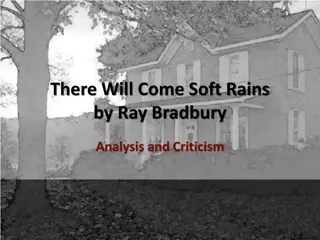A Look into Adrienne Kennedy's Play: Funny House of Negro
African-American dramatist Adrienne Kennedy's first produced play, "Funny House of Negro," explores themes of race, identity, and self-hatred through the character Sarah's hallucinatory subconscious. Set in the 1960s, the play embodies a revolutionary portrayal of the black female experience. With a unique scenic idiom, Kennedy delves into Sarah's inner selves, such as the Duchess of Hapsburg and Jesus, to depict a poignant narrative of struggle and alienation.
Download Presentation

Please find below an Image/Link to download the presentation.
The content on the website is provided AS IS for your information and personal use only. It may not be sold, licensed, or shared on other websites without obtaining consent from the author.If you encounter any issues during the download, it is possible that the publisher has removed the file from their server.
You are allowed to download the files provided on this website for personal or commercial use, subject to the condition that they are used lawfully. All files are the property of their respective owners.
The content on the website is provided AS IS for your information and personal use only. It may not be sold, licensed, or shared on other websites without obtaining consent from the author.
E N D
Presentation Transcript
Unit 5 African Literature (Advance) Funny House of Negro by Adrienne Kennedy Biography of the Author: African-American dramatist, born in Cleveland, Ohio, educated at Ohio State University. She began working as a playwright during a visit to West Africa during 1960 1, which gave her a sense of connection with African culture and introduced her to the work of Chinua Achebe and Wole Soyinka. In Funny house of a Negro (1962), her first play, Kennedy uses a scenic idiom in which the dream-scape of hallucination and nightmare voices is developed through the impersonation of several historic personalities, Queen Victoria, the Duchess of Hapsburg, Jesus Christ, and Patrice Lumumba.
A Little History of the Play Funny house of a Negro is a one-act play by Adrienne Kennedy. The play opened off- Broadway in 1964 and won the Obie Award for Distinguished Play. The play shared this award with Amiri Baraka's Dutchman, and was influenced by both the Black Arts Movement and the Theater of the Absurd. Genre: Drama, one-act play
Background of the Play Making its debut on January 14, 1964, at the East End Theater in New York City, Funny house of a Negro was Adrienne Kennedy s first produced play. Early on, critics and audiences recognized the importance of the work. It received an Obie Award from The Village Voice for most distinguished play and continued to be produced in the United States and abroad throughout the 1960s. The play chronicles the last hours in the life of Sarah, a young black woman troubled by race and identity. Kennedy s depiction of Sarah s hallucinatory subconscious struggling with self-hatred, race hatred, and alienation from the larger culture was regarded as powerful by some critics of the era. Other critics were confused by the staging and subject matter of the work. Many scholars contend that Funny house of a Negro was revolutionary in a number of ways, especially Kennedy s unique portrayal of what it was like to be black and a woman in the United States in the 1960s.
Character analysis Mrs. Conrad See Landlady Duchess of Hapsburg The Duchess is one of Sarah s inner selves, arguably the closest to Sarah s true self. She represents the aspect of Sarah s subconscious that is racist. She blames her father for her mother s death. Like all the inner selves, she has lost almost all of her hair. Funny house Lady See Landlady Funny house Man See Raymond Jesus One of Sarah s inner selves, Jesus is a hunchbacked dwarf with yellow skin. Sarah describes him as the son of Queen Victoria. He shares the Duchess of Hapsburg s disdain of Sarah s father. Jesus decides to hunt down and kill Patrice Lumumba. Like all the inner selves, he loses almost all of his hair.
Characters Landlady The Landlady is a white woman who runs the boarding house where Sarah lives. She comments on the action and Sarah s life, providing a needed perspective on what is happening. She believes that Sarah has hidden in her room ever since Patrice Lumumba was murdered and her father hung herself in a Harlem hotel. The Landlady also says that Sarah s hair has fallen out because of her suffering. She offers insight into Sarah s father s background, and recalls incidents in which he tried to reconcile with his daughter. It is the Landlady who discovers that Sarah has killed herself. Patrice Lumumba Patrice Lumumba is one of Sarah s inner selves. He is a black man whose head is split in half; his eyes have blood and tissue in them. He carries an ebony mask. Patrice seems to represent Sarah s father, though he describes himself in the exact same words that Sarah uses to describe herself. Yet he also introduces the theme of self-hatred in the play. Like all the inner selves, Patrice has lost his hair. Man See Patrice Lumumba
Characters Queen Victoria Regina Queen Victoria is one of Sarah s inner selves; she looks exactly like the Duchess of Hapsburg. Sarah describes her as the mother of Jesus. She describes how Sarah s father searched for her. Like the other inner selves, Queen Victoria loses most of her hair during the play. Raymond Raymond is a Jewish poet who lives above Sarah in the rooming house. She describes him as a boyfriend who is interested in African Americans. At the end of the play, Raymond is present when the Landlady discovers that Sarah has killed herself. He informs the Landlady that Sarah s father is a doctor married to a white woman. It seems that Sarah s father never committed suicide. Sarah Sarah is the protagonist of the play and is represented on stage by four of her inner selves: Queen Victoria, the Duchess of Hapsburg, Jesus, and Patrice Lumumba. Only a few facts are clear among the many versions of her reality. Sarah is the product of an interracial marriage: her mother is white and her father is African-American. She studied English at a college in New York City, writes poetry, and works as a librarian. She lives in a brownstone rooming house in New York City.
Themes Identity At the core of Funny house of a Negro is Sarah s internal struggle to understand and accept her identity as an African American woman in the United States. Each of Sarah s four selves her subconscious s Alienation and Loneliness Sarah s problems with identity in Funny house of a Negro lead to alienation and loneliness. Because she is of mixed heritage and she has confused ideas about what each heritage represents she feels alienated from both black and white cultures. This alienation leads to loneliness. It is implied that Sarah s father has made numerous attempts to reach his daughter, but she has rejected him repeatedly. Some of her selves claim that he killed himself. So she rejects that side of herself. Sarah also rejects the white side of herself. She claims her mother is dead or in an asylum. Her landlady does not understand her. Sarah says she does not love her white Jewish boyfriend, a poet named Raymond. She claims, He is very interested in Negroes, which implies he is not interested in Sarah for herself, but her racial identity.
Style Because Funny house of a Negro is a play that takes place inside Sarah s mind, only a few aspects of the setting are real. Set in the early 1960s, the play takes place in Sarah s room in a New York City brownstone. Her room features a large statue of Queen Victoria, other pictures of British monarchs, books, a bed, and a writing table. Some of the realistic action takes place on the landing and inside Raymond s room. The play has several settings specific to Sarah s four selves. For example, the Queen has her own chamber with a tomb-like mahogany bed, a chandelier, and walls the color of wine. The Duchess has her own space: a ballroom with a chandelier, marbled floor, fake snow, and benches. In the final scenes, a jungle replaces these rooms, altering their symbolic meaning.
Symbolism Many of the ideas in Funny house of a Negro are expressed by numerous symbols and images. Very little is realistic in the play. Even the characters are symbolic. Sarah s four selves represent different aspects of her identity: the Duchess and Queen Victoria wear masks or mask-like makeup and white clothing reminiscent of funeral shrouds; Jesus is a yellow-skinned hunch-backed dwarf; and Patrice Lumumba carries an ebony mask. The character of Sarah s mother is even more symbolic she carries a bald head as she moves across stage several times. While Sarah s mother is mentioned frequently, she speaks only once. Sarah s mother only flits through her daughter s unconscious: she is only to be discussed and interpreted, not really understood. Kennedy s stage directions call for numerous physical symbols and complex images. For example, Sarah s room is dominated by a statue of Queen Victoria, a white ideal of purity and royalty that she will never be able to match. Sarah walks around with a noose around her neck and a bloody face before the audience is told that she is dead. This emphasizes her inner pain as well as her eventual fate.
Symbol of Hair Adrienne Kennedy s Funny house of a Negro uses the symbol of hair to highlight Sarah s obsession with hair and baldness throughout the text. Sarah obsesses over the fact that hair is the prominent aesthetic difference between black and white people and this drives her mad. Kennedy s use of hair emphasizes the idea that Sarah tried to disown, and then kill, the African American part of her background. When the play opens, the first character seen on stage is a representation of Sarah s mother whose, hair is wild, straight and black and falls to her waist. Sarah s mother is the only female character inside Sarah s mind that fully retains her hair
Title Significance of Title: Funny house of a Negro signifies the playwright s personal experiences and several social concerns and criticism that come from the public. Everything is portrayed in a deliberately nonrealistic, often dreamlike style of dramatic presentation. The title shows how open to criticism and humor the characters are
Conclusion Funny house of the Negro demonstrates how a person can be emotionally and mentally damaged by something that didn t directly involve them. Sarah experiences self-hatred because of her blackness and what it represents in her life: her father; the man who raped her mother. The fact that Sarah's father kills himself because of her rejection serves to damage her further. The effect of having nobody to support her or tell her the truth of what happened between her mother and father (the end of the play implies that the story Sarah knew may not have been true) causes her to create multiple versions of herself to make sense of what was happening. To pathologies Sarah's experience in the play, both multiple personality disorder and schizophrenia seem possible. The audience can t tell whether she s speaking out loud when she interacts with these characters, which would differentiate those two disorders. It's hard to distinguish whether or not the audience is experiencing the play through her head or if it's happening in the real world. Either way, Sarah has mental and emotional issues that ultimately lead to her death.
Reference Recommended Book: 1. Docherty, T. (1992).Postmodernism: A R e a d e r . Hemal Hempstead: Harvester Wheatsheaf. 2. Eagleton, M. (1991). Feminist Literary Criticism . London: Longman.























